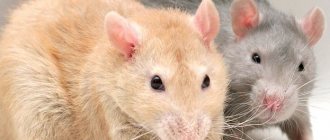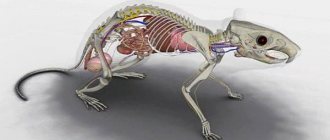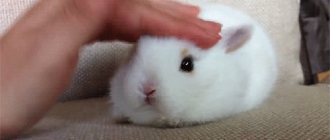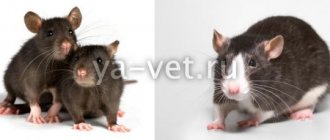Rodents are often kept as pets for children. But rats are one of those animals that quite adult, adequate people willingly keep at home. Simply because they fell in love with these animals. Before buying a pet, you should weigh all the pros and cons of pet rats. A living being is a great responsibility. Perhaps, after reading this article, you will prefer to get another rodent (for example, a guinea pig) or even wait until “adding.” I became infected with rat mania as a child. Although there are no rats living in my house now, I still hope that the children will grow up and help me persuade my husband to get a couple of rats. I promise to tell you about the disadvantages of decorative rats. After all, rave reviews from rat breeders on the Internet are not very helpful. It is the shortcomings and content issues that should be of interest to a beginner in the first place. Well, if they don’t scare you, welcome to the society of rat lovers.
Author of the article: Olga Shiltsova, practicing veterinarian, author of the books “Dachshund of Fate” and “Tails of Fortune”
What kind of domestic rodents exist: list of species, how long do they live at home?
Pet rodents
Pet rodents are deservedly popular. Small furry animals are funny, cute and relatively unpretentious - they are easier and more economical to keep than a cat or dog. There are several types of rodents that are suitable for living at home. Here is the list:
- Common hamsters
- Djungarian hamsters
- Guinea pigs
- Decorative rabbits
- Chinchillas
- Gerbils
- Rats, etc.
Decorative rats occupy not the last place among pet rodents. They are distinguished by intelligence, affection and learning ability, as well as greater cleanliness than is commonly thought.
Difficulties in keeping rodents can arise due to their need to sharpen their teeth. Rodents are rodents: they love to taste everything, even wires. Disadvantages include the low life expectancy of animals at home. If guinea pigs can live 6-8 years , then rabbits and chinchillas can up to 15 years . The lifespan of other small rodents is about 3 years . This also applies to decorative rats. When choosing a pet (especially for a child), you need to keep this in mind to avoid future stress.
The main advantages of keeping a rat
Fortunately, the advantages of decorative rats are much greater than the disadvantages. Below are listed only the main positive qualities of the animals.
High socialization
Rats do not tolerate loneliness very well; they prefer to live in small same-sex groups. At the same time, animals show care for their relatives:
- brush each other's fur coats;
- feed weakened individuals;
- show sympathy;
- warn of impending danger.
Fights and conflicts between rats are a very rare phenomenon, which is observed mainly in males during sexual activity.
High cognitive abilities
Contrary to popular belief, rats are very smart. Their intellectual abilities are on par with cats and dogs. Rodents remember their name well and are easy to train.
Fluffies can be taught on their own such commands as “give me a paw”, “lie down”, “come to me”. Rats also perform simple tricks - walk on their hind legs, roll a ball, spin around their own axis, jump from place to place.
Easy to care for
The cute fluffies are quite easy to care for. Difficulties may arise at first, but the main thing is to get used to it. By choosing a cage with a removable tray, cleaning takes literally 10-15 minutes.
Sawdust or shredded toilet paper are used as filler. You can feed your rodent either specialized food or natural food. The only caveat is that you need to remember the list of prohibited products.
Doesn't take up much space
Decorative rats are quite compact. Their body length is about 20 cm. Therefore, several individuals can be kept in one multi-tiered cage at once - up to 5-6 pieces. The rat house itself does not take up much space. The cage will easily fit on a desk or bedside table.
Affordable price
The price of a decorative rat, even one raised in the most prestigious nursery, is unlikely to rise above 2,000 rubles. And at the poultry market or by hand you can buy a purebred pet for only 500-700 rubles.
It is better to buy rats from professional nurseries. Because pups raised by experienced breeders are more socialized and healthier.
Easy to transport
Rats tolerate moving well even over long distances. All that is required for comfortable transportation is a special carrier with a secure lock, while ensuring air circulation. The small weight of the animal - within 500 grams - will prevent the owner from getting tired during the trip.
Big choice
There are many breeds of decorative rats, so everyone will find a pet to their liking. Among the varieties there are different animals: compact and bulky, bald and fluffy, with straight and curly hair, with large and small ears, albino and fluffy with complex colors.
Cleanliness
Many people believe that the destiny of rats is to climb through garbage dumps and rummage through garbage. However, ornamental animals are very different from pasyuki. Cute fluffies are very clean.
They perform daily activities to maintain the cleanliness of their body: they wash themselves after each meal and lick their fur. And if several individuals live in a cage, they happily clean each other’s fur coats. In addition, decorative rats love to swim. The owner must take care of organizing water procedures.
Attachment to the owner
Rats quickly get used to their new owner and happily spend time with him. In addition, cute animals gradually get used to the rest of the family members. If a rodent feels good about itself, it will never bite, scratch or run away from home.
Possibility of litter training
Rats are very smart, so they can be trained to go to the toilet in one designated place. This will only require a few trays (according to the number of pets in the cage) and a little patience.
The duration of toilet training is from 2 to 4 weeks. If the rat gets used to the litter box, the process of cleaning the cage will take much less time.
Activity
Decorative rats are very active - they really like to play with their relatives, exercise on apparatus in the cage, and explore everything new. It is very interesting to observe the life of fluffies from the outside. If you have free time, you can spend hours on end watching cute animals frolic.
Since rats are very active, it is better to purchase multi-tiered cages for playful animals. 2-3 floors will be enough for males, 4-5 tiers for females.
No need to spend a lot of time together
Rats love their owners very much and are always willing to play with them. But if the furry owner doesn’t have much time to spend together, it’s okay. Fluffies are able to keep themselves busy - they exercise on apparatus, play, and frolic with their cage neighbors. At the same time, the rodent does not develop any resentment towards humans.
No need to go outside
Other pets, such as cats and dogs, need a lot of space. In addition, such large pets prefer to go to the toilet outside.
With rats everything is much simpler. The little animal feels quite comfortable in a cage. And to release the accumulated energy, a play complex installed in a cage is enough for a rodent.
Domestic decorative rats: gender differences in appearance
Male and female house rats are equally cute and fluffy, but differ slightly in appearance. The main indicators are size, body shape and coat properties. Gender differences in appearance are described below.
Male rats by :
- Larger size and weight
- Quite hard, dense wool
- Pear-shaped body structure
The distinctive features of a girl rat are:
- Smaller body size compared to males
- Elongated torso
- Silky, smooth and shiny fur
In addition to appearance, an important criterion for owners is the smell. Males smell stronger, mainly due to their habit of marking territory. However, with good care you can reduce it to a minimum.
Cons of content
Unfortunately, rats do not have their drawbacks. But the shortcomings of these cute rodents are very minor, and they can be easily dealt with.
Tendency to diseases
Rats have a fairly weak immune system, so fluffies often get sick. In addition, a predisposition to certain diseases is inherent in them at the genetic level. Most often, rodent owners encounter the following ailments of their pets:
- ARVI;
- malignant and benign neoplasms;
- mycoplasmosis;
- atherosclerosis;
- renal failure;
- pneumonia.
Rats also often suffer from fleas, lice, ticks, worms and other parasites.
Short lifespan
On average, rats live about 3 years. Compared to other types of pets, this is a very short period of time. Some varieties of decorative rats, for example, albinos, live only 1.5-2 years. Long-livers are also found among rodents. With proper care and timely treatment, a rat can live up to 4-4.5 years.
Marking territory
Some novice breeders mistakenly believe that only males mark territory. However, females also put their marks everywhere. The only difference is that the urine of male rats has a more pungent, specific odor. Regular cleaning of the cage will help solve this problem.
Unpleasant smell
During the life of a rat, like any other animal, an unpleasant odor is released. And it doesn't just come from excrement or urine. The endocrine glands also emit a specific aroma, to get rid of which you will have to regularly subject your pet to water procedures.
Unpleasant associations
The appearance of rodents, to put it mildly, scares some people away. Some consider cute decorative fluffies to be as aggressive as their wild relatives. And some breeds, for example, the Sphynx, are generally terrifying to especially impressionable people.
Damage to things
As long as the rat is in the cage, its owner’s property is completely safe. But rodents are very agile and are able to open a weak lock on their own. If he escapes, the fluffy will chew everything that gets in his way - furniture, wallpaper, clothes, wires. Therefore, it is recommended to place even a cage with a rat away from walls and any things - otherwise the rat can reach them through the twigs.
Noise at night
Rats are nocturnal animals. Therefore, they often go to bed only in the morning. And at night they stay awake, play, frolic, learn everything new. This feature can cause discomfort to owners, especially if small children live in the house. To ensure that pets do not disturb anyone’s sleep, it is better to place the cage in a separate room.
Aesthetic problems
Adult male rats have very prominent genitals. This is especially noticeable in representatives of short-haired and hairless varieties. This feature is very off-putting or confusing for some people.
Expensive treatment
The health of rats is quite poor; fluffies get sick very often. Therefore, they will have to be treated constantly, paying considerable sums for medical services. Moreover, ordinary veterinarians rarely work with such small animals as rodents. Most likely, you will need to look for a special doctor for rats - a ratologist.
The problem is aggravated by the fact that there is only one specialist for 2-3 cities. Therefore, for treatment, you may have to transport the animal to a neighboring village.
The behavior of decorative rats: how does it differ between boys and girls?
Decorative rats
Babies of decorative rats show almost no gender differences in behavior. They appear as the animal matures. How is it different for boys and girls?
The greatest inconvenience can be caused by teenage males ( 6-8 months ):
- Due to age-related changes, they become aggressive, and not only towards their relatives, but also towards humans. Although this is a temporary condition, it should not be forgotten, especially if there are children at home.
- Adult male rats are usually calm, phlegmatic and affectionate.
- They love to sit on their owner and enjoy being scratched.
- To keep them, a spacious cage with room for houses and hammocks is desirable, as these animals love to swing.
Rats are social animals, so it is recommended to keep them in same-sex pairs. However, a fight for leadership may flare up between a pair of males. To avoid competition between animals, it is necessary to take rat pups of the same age and litter. However, male rats easily tolerate loneliness if the owner pays them enough attention.
Important: Due to their calmness and low mobility, male rats are prone to obesity, so try not to overfeed the animal.
Female rats:
- Active, mobile and curious.
- They have no hierarchy, and the girl friends form a conflict-free couple.
- They love to play with each other and with various objects.
- You can put toys in their cage and provide them with holes and tunnels.
- Females are also more clean and tidy, and when properly kept, they have virtually no odor.
- The activity of female rats requires more attention to them - curious animals will try everything, and when walking they can run away.
Important: Female rats are prone to mammary tumors. This problem can be solved in advance by sterilizing the animal. If you are keeping a rat for breeding, monitor its health and promptly contact a veterinarian.
Domestic rat: reviews
“I love both cats and dogs, but I’m not ready to keep them at home. But I have a special love for rats. This is my spirit animal or something. Creatures close to our hearts have gone to the rainbow many times already. Thanks to them, I learned to relate to death more easily.”
“My girls are just incredibly cute, despite their long hairless tails. I taught them several commands. My favorites are “circle” and “serve.” When I myself was eating something delicious, Sonya would run up and start spinning wildly in place so that she could be treated. Affectionate, curious, cheerful"
“I speak from personal experience – males are much more “fragrant” than girls. My Francis wrote everywhere. Notebooks and textbooks were stained with yellow, and clothes had to be washed every day. Mom was terrified. Well, of course he chewed up the furniture a lot. When he passed away, I was categorically forbidden to get a new rat. I still remember my first pet with tenderness.”
“In my opinion, rats are the only rodents that become attached to humans. They are also cunning, curious, clever thieves. They can bite – most often without understanding what’s what. That’s why you shouldn’t stick your fingers into the cage through the bars, and also don’t try to kiss if your breath smells strongly of food.”
“My rat lived for more than 3 years and weighed 700 grams. Calm and approachable, he was my favorite. He was not afraid of either a cat or a dog, but they respected him. He pulled out fluff from cats for nesting and stole dog food. Mr. Rat (we never gave him another name) walked freely throughout the apartment, voluntarily returning to the cage as if it were his home. There was no unpleasant smell from the cage, you just need to clean it more often! The breakup was hard, and this is the only reason I didn’t get a rat again.”
I strongly advise all rat breeders, present and future, to read the book by science fiction writer Olga Gromyko - “Rat Ratcats. The life of a rat in stories and pictures.” She conveys the characteristics of these animals amazingly and with humor.
How to determine the sex of a baby rat?
Determining the sex of a baby rat
Males and female domestic rats are distinguished, like all animals, by gender. How to determine the sex of a baby rat?
- To do this, you need to hold the rat in your palm with its tail down, carefully holding its head. You can carefully turn the animal onto its back.
- Signs of a male are testicles under the tail, absence of nipples and a significant ( about 6 mm ) distance from the anus to the urethra .
- Females , accordingly, have a double row of mammary glands on the abdomen, no testicles, and the distance from the urethra to the anus is smaller - about 3 mm .
Important : Do not hold a rat by the tail under any circumstances - this is a lot of stress for the animal. Carry out the inspection carefully and carefully.
Diet of a decorative rat
Despite the general unpretentiousness, each type of rat may have its own favorite types of dishes that it prefers. To avoid a number of health problems, it is necessary to accustom your pet to a proper diet from a young age. A balanced diet for an animal should include the following products in different proportions:
Cereals
Crushed and dry cereals, as well as rice and barley porridges, are allowed.
Nuts and seeds
The seeds are suitable for pumpkin, sunflower, as well as sprouts of oats, wheat, and so on. You can give them to your pet in the form of dietary supplements.
Various fermented milk products
The main thing is that the products have moderate or low fat content.
Meat products and pure protein
It’s better not to rely heavily on protein sources, but you shouldn’t allow a deficiency either.
Vegetables
The fiber contained in vegetables stimulates the functioning of the intestines and the general gastrointestinal system.











